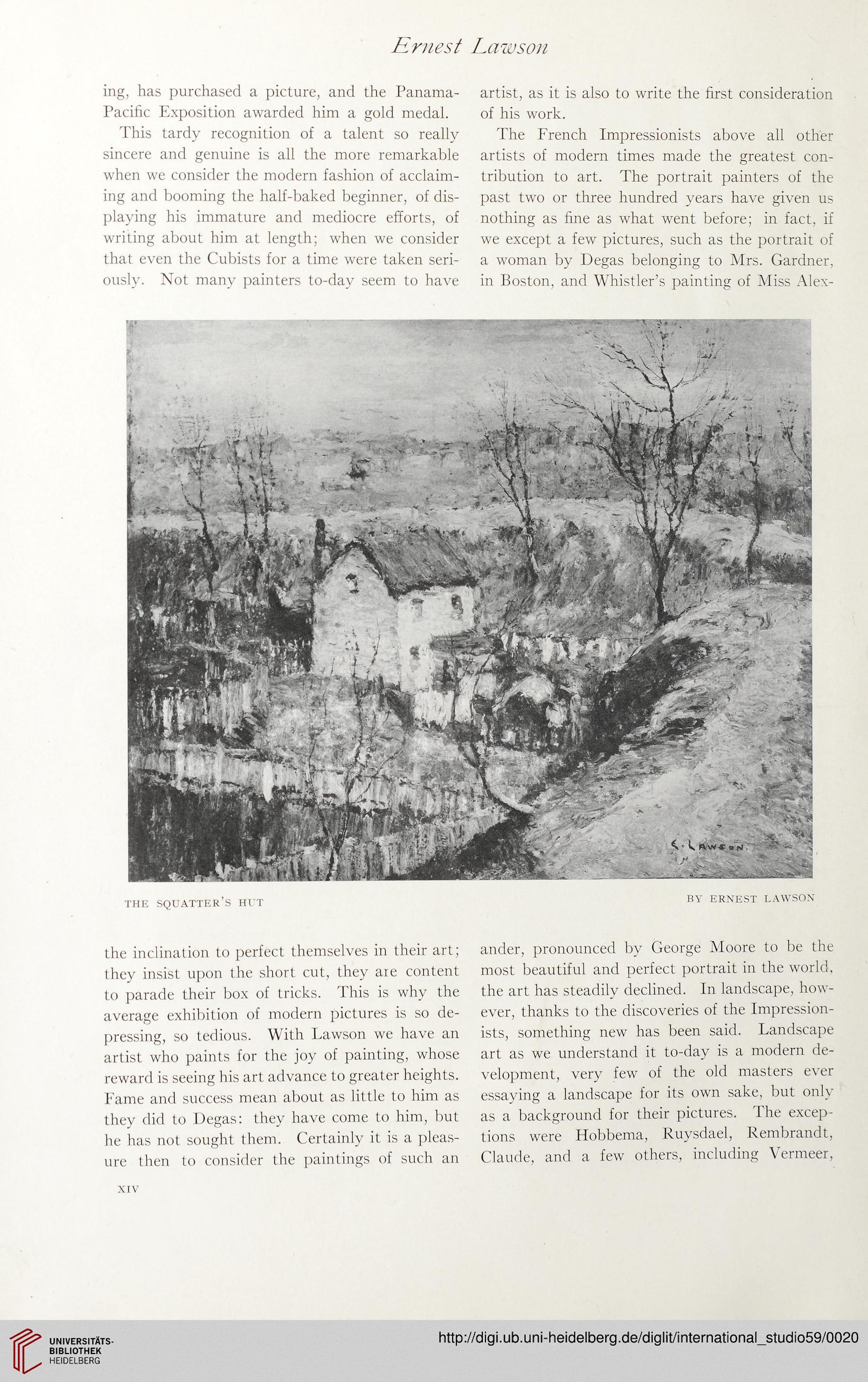Ernest Lawson
ing, has purchased a picture, and the Panama-
Pacific Exposition awarded him a gold medal.
This tardy recognition of a talent so really
sincere and genuine is all the more remarkable
when we consider the modern fashion of acclaim-
ing and booming the half-baked beginner, of dis-
playing his immature and mediocre efforts, of
writing about him at length; when we consider
that even the Cubists for a time were taken seri-
ously. Not many painters to-day seem to have
artist, as it is also to write the first consideration
of his work.
The French Impressionists above all other
artists of modern times made the greatest con-
tribution to art. The portrait painters of the
past two or three hundred years have given us
nothing as fine as what went before; in fact, if
we except a few pictures, such as the portrait of
a woman by Degas belonging to Mrs. Gardner,
in Boston, and Whistler’s painting of Miss Alex-
THE SQUATTER’S HUT
BY ERNEST LAWSON
the inclination to perfect themselves in their art;
they insist upon the short cut, they are content
to parade their box of tricks. This is why the
average exhibition of modern pictures is so de-
pressing, so tedious. With Lawson we have an
artist who paints for the joy of painting, whose
reward is seeing his art advance to greater heights.
Fame and success mean about as little to him as
they did to Degas: they have come to him, but
he has not sought them. Certainly it is a pleas-
ure then to consider the paintings of such an
ander, pronounced by George Moore to be the
most beautiful and perfect portrait in the world,
the art has steadily declined. In landscape, how-
ever, thanks to the discoveries of the Impression-
ists, something new has been said. Landscape
art as we understand it to-day is a modern de-
velopment, very few of the old masters ever
essaying a landscape for its own sake, but only
as a background for their pictures. The excep-
tions were Hobbema, Ruysdael, Rembrandt,
Claude, and a few others, including Vermeer,
xiv
ing, has purchased a picture, and the Panama-
Pacific Exposition awarded him a gold medal.
This tardy recognition of a talent so really
sincere and genuine is all the more remarkable
when we consider the modern fashion of acclaim-
ing and booming the half-baked beginner, of dis-
playing his immature and mediocre efforts, of
writing about him at length; when we consider
that even the Cubists for a time were taken seri-
ously. Not many painters to-day seem to have
artist, as it is also to write the first consideration
of his work.
The French Impressionists above all other
artists of modern times made the greatest con-
tribution to art. The portrait painters of the
past two or three hundred years have given us
nothing as fine as what went before; in fact, if
we except a few pictures, such as the portrait of
a woman by Degas belonging to Mrs. Gardner,
in Boston, and Whistler’s painting of Miss Alex-
THE SQUATTER’S HUT
BY ERNEST LAWSON
the inclination to perfect themselves in their art;
they insist upon the short cut, they are content
to parade their box of tricks. This is why the
average exhibition of modern pictures is so de-
pressing, so tedious. With Lawson we have an
artist who paints for the joy of painting, whose
reward is seeing his art advance to greater heights.
Fame and success mean about as little to him as
they did to Degas: they have come to him, but
he has not sought them. Certainly it is a pleas-
ure then to consider the paintings of such an
ander, pronounced by George Moore to be the
most beautiful and perfect portrait in the world,
the art has steadily declined. In landscape, how-
ever, thanks to the discoveries of the Impression-
ists, something new has been said. Landscape
art as we understand it to-day is a modern de-
velopment, very few of the old masters ever
essaying a landscape for its own sake, but only
as a background for their pictures. The excep-
tions were Hobbema, Ruysdael, Rembrandt,
Claude, and a few others, including Vermeer,
xiv




